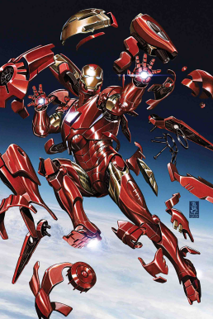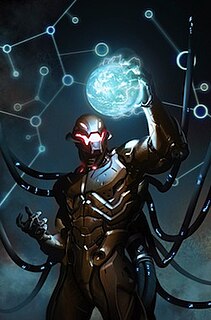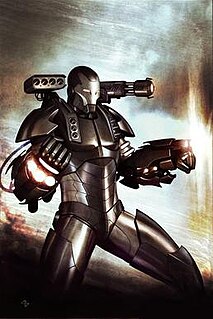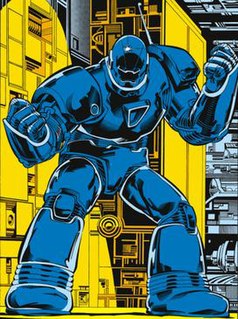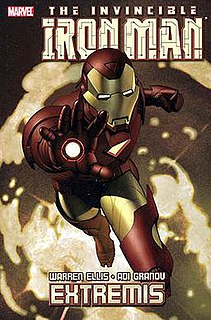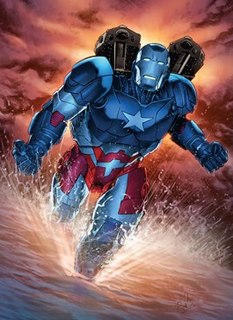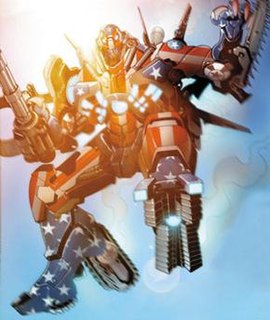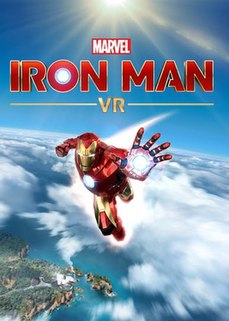| Name | Introduced | Notes |
|---|
| Main armor |
|---|
| Mark I | Iron Man | Created by Tony Stark and Ho Yinsen, the suit left the back and knees vulnerable. It had flamethrowers and a missile launcher, and was capable of one short burst of flight before it crashed. [15] This armor is destroyed during the attack on Stark's house in Iron Man 3. |
| Mark II | This armor improves flight capabilities, adds a heads-up-display and repulsors, and has a built in arc reactor. However, the suit experiences icing problems when flown at too high an altitude. The suit needs a special construction/removal apparatus to get in and out of the armor. [15] This armor is destroyed during the attack on Stark's house in Iron Man 3. |
| Mark III | The Mark III fixes the freezing problem by changing the suit to a gold-titanium alloy. It also adds wrist-mounted missiles, hip-mounted flare launchers and shoulder-mounted machine guns. This is the first armor to feature the classic red and gold color scheme. [15] This armor is destroyed during the attack on Stark's house in Iron Man 3. |
| Mark IV | Iron Man 2 | Not much is known about the Mark IV as it is briefly seen when Stark enters the Stark Expo 2010. However, it does have a manually removable helmet. [15] This armor is destroyed during the attack on Stark's house in Iron Man 3. |
| Mark V | The Mark V is a travel, portable suit, also known as the "suitcase suit", [10] that assembles around Stark's body. Not much else is known about the armor, such as if it has flight capabilities. [15] The armor takes on a red and silver color scheme, similar to the Silver Centurion armor from the comics. [9] This armor is destroyed during the attack on Stark's house in Iron Man 3. |
| Mark VI | This armor changes the arc reactor hole to a triangular shape instead of the traditional circular one. The armor also upgrades its artillery to include a grenade launcher in one arm, a missile launcher in a shoulder and metal-slicing super lasers in both arms (though this can only be used once). The color scheme is once again the classic red and gold. [15] This armor is destroyed during the attack on Stark's house in Iron Man 3. |
| Mark VII | The Avengers | The suit is able to assemble around Stark via bracelets worn by him, and brings back the circular arc reactor hole. The suit is not designed for deep space travel. This armor is destroyed during the attack on Stark's house in Iron Man 3. |
| Mark XLII | Iron Man 3 | This prehensile suit [16] is able to be summoned remotely by controlling each individual piece of the armor, through state-of-the-art chips in Stark's body, and features an inverse color scheme to the other main armors, with gold as the predominant color. [17] [18] Stark is able to operate the suit externally from a remote location. This armor is destroyed at the end of Iron Man 3. |
| Mark XLIII | Avengers: Age of Ultron | This suit is identical to the Mark XLII, but with an inverse red/gold color scheme. [19] The Mark XLIII has an unmanned sentry mode that allows Stark to exit the suit and remained protected. It can also be augmented with the Mark XLIV "Veronica" modular add-on in order to take on the Hulk. |
| Mark XLV | Featuring a predominantly red color scheme and a hexagonal-shaped arc reactor, Stark wears this suit during the Avengers' final confrontation with Ultron in Sokovia. [20] |
| Mark XLVI | Captain America: Civil War | Visually similar to the Mark XLV with a pentagon-shaped arc reactor. [21] The helmet is retractable and able to fold into the back of the suit. The suit uses hybrid nanotechnology, and is an homage to the character's Bleeding Edge armor from the comics. [22] |
| Mark XLVII | Spider-Man: Homecoming | A predominately silver color scheme with the head, chest and extremities also featuring gold and red. The armor is visually similar to the one worn by Ultimate Iron Man in the comics. [23] Like the Mark XLII, the armor can be controlled remotely by Stark. |
| Mark L | Avengers: Infinity War | Known as the Bleeding Edge armor, it has rocket thrusters that allows Stark to travel in deep space. The suit has the ability to form around Stark out of his arc reactor using nanotechnology, which can regenerate itself if it sustains damage. [24] [14] Visually, this armor is based on the Model Prime armor from the comics. [25] The mark number has been stylized as both decimal (50) and Roman numeral (L). [14] [26] |
| Mark LXXXV | Avengers: Endgame | This armor has a similar look to the Mark L, with gold upper sleeves, shoulder guards, and a slightly bulkier design. [27] It retains the nanotechnology from the Mark L and has the ability to form an Infinity Gauntlet. [28] |
| Iron Legion |
|---|
These armors were created before the beginning of Iron Man 3 by Stark to help in different types of situations he might encounter. They are first referenced to as the "Iron Legion" in the Iron Man 3 Prelude #2 comic. [29]
These armors are destroyed at the end of Iron Man 3. |
|---|
| Mark VIII | Iron Man 3 | [16] |
| Mark IX | [16] |
| Mark X | [16] |
| Mark XI | [16] |
| Mark XII | [16] |
| Mark XIII | [16] |
| Mark XIV | [16] |
| Mark XV | The stealth suit, known as "Sneaky". It is virtually invisible to enemy early-warning systems. A chrome colored coating on the armor can darken or lighten to match the environment. [17] |
| Mark XVI | The black stealth suit, known as "Nightclub". Similar to the Mark XV armor. However, it does not have all of the weapons and is designed for stealth missions. [17] |
| Mark XVII | The artillery level repulsor transmitter (RT) suit, known as "Heartbreaker". [30] It has an oversized chest RT, which can fire powerful blasts and can fire narrow or wide beams. It can also generate a repulsor shield for protection. [17] |
| Mark XVIII | The stealth artillery level RT suit, known as "Casanova". [16] |
| Mark XIX | The high velocity prototype suit, known as "Tiger". [16] |
| Mark XX | The long distance suit, known as "Python". [16] |
| Mark XXI | The high altitude suit, known as "Midas". [16] |
| Mark XXII | The War Machine 2.0 prototype, known as "Hot Rod". [16] |
| Mark XXIII | The extreme heat suit, known as "Shades". [16] |
| Mark XXIV | The heavy combat suit, known as "Tank". [16] |
| Mark XXV | The heavy construction suit, known as "Striker". It was designed to help with construction. Its powerful jackhammer-like arms can pulverize concrete and can withstand high temperatures and electrical surges. [17] This suit is also known as "Thumper". [16] |
| Mark XXVI | The heavy construction suit upgrade, known as "Gamma". [16] |
| Mark XXVII | The chameleon suit, known as "Disco". [16] |
| Mark XXVIII | The radiation zone suit, known as "Jack". [16] |
| Mark XXIX | The nimble construction suit, known as "Fiddler". [16] |
| Mark XXX | The "Silver Centurion" suit upgrade, known as "Blue Steel". [16] |
| Mark XXXI | The high velocity centurion suit, known as "Piston". [16] |
| Mark XXXII | The enhanced RT suit, known as "Romeo". [16] |
| Mark XXXIII | The enhanced energy suit, known as "Silver Centurion". [30] The suit has a slight protective force field, which allows it to attract or repulse objects using magnetic polarity. The suit is capable of firing pulse cannons that build in intensity the further they travel. [17] |
| Mark XXXIV | The disaster rescue prototype suit, known as "Southpaw". [16] |
| Mark XXXV | The disaster rescue suit, known as "Red Snapper". [30] It was designed to survive in dangerous places and has extendable arms and claws making it ideal for disaster rescue. [17] |
| Mark XXXVI | The riot control suit, known as "Peacemaker". [16] |
| Mark XXXVII | The deep sea suit, known as "Hammerhead". It was designed to be able to travel to the deepest parts of the ocean where it can withstand extreme pressure, and has high-power work lights to allow visibility in murky waters. [17] |
| Mark XXXVIII | The heavy lifting suit, known as "Igor". [30] The suit was not designed for battle, but for heavy lifting and carrying heavy objects. [17] |
| Mark XXXIX | The sub-orbital suit, known as "Gemini". [30] It was designed for otherworldly journey and has an integrated, removable booster pack and zero-gravity maneuvering thrusters. [17] This suit is known as "Starboost" in the official Iron Man 3 game. [31] |
| Mark XL | The hyper velocity suit, known as "Shotgun". [30] It was designed for hypersonic speed and can travel in excess of Mach 5. [17] |
| Mark XLI | The skeleton suit, known as "Bones". It is a black and gold, lighter version of a full Iron Man suit, with a focus on speed and maneuverability. [17] |
| Other armors |
|---|
| Mark XLIV | Avengers: Age of Ultron | A modular add-on known as the Hulkbuster armor, it was developed by Tony Stark and Bruce Banner, after they studied the Hulk's physical actions and strength levels in an effort to find a way to contain him and minimize the damage caused by his rages. [32] [13] [33] [34] Its codename is "Veronica", in a reference to Archie Comics. Bruce Banner is involved with Betty Ross, so Age of Ultron director Joss Whedon went for the two women that dispute Archie Andrews' affection - "the opposite of Betty is Veronica". [35] |
| Mark XLVIII | Avengers: Infinity War | An update to the Mark XLIV modular add-on, and known as Hulkbuster 2.0, it features a sleeker, less blocky design, with additions of silver in its color scheme. [36] Unlike the original Hulkbuster, it can apparently be used on its own without being 'worn' over another armor, with Banner using the Hulkbuster during the battle for Wakanda against Thanos's forces when he finds himself unable to transform into the Hulk. |
| War Machine armors |
|---|
| War Machine Mark I | Iron Man 2 | Originally the Iron Man Mark II armor, this suit is confiscated by James Rhodes on behalf of the US Government and enhanced by Justin Hammer. Hammer adds machine guns in the wrists, a minigun on the right shoulder and a grenade launcher on the left. The armor still retains repulsors in the chest and hands. [15] In the Iron Man 3 prequel comic, Stark reclaims the Mark II armor from Rhodes and removes all the modifications done to it by Hammer. [37] |
| War Machine Mark II / Iron Patriot | Iron Man 3 | The second War Machine armor, given to James Rhodes by Stark, has a rectangular-shaped chestplate protecting the arc reactor assembly. [37] In Iron Man 3, Rhodes was asked by the president to take on the moniker, "Iron Patriot", and add a red, white, and blue color scheme to be used as the government's "American hero" symbol in response to the events in The Avengers. [38] The armor reverts to the grey and silver color scheme in Avengers: Age of Ultron. [39] |
| War Machine Mark III | Captain America: Civil War | The armor worn in Civil War appears similar to the others seen. It is damaged through 'friendly fire' when Rhodes was pursuing Wilson and a stolen Quinjet piloted by Rogers and Barnes, and is struck by a beam fired by the Vision. [40] |
| War Machine Mark IV | Avengers: Infinity War | This version of the armor includes an 'exo-skeleton' worn on his legs and lower back when Rhodes is not wearing the full armor, allowing him to walk despite the spinal injuries sustained in Civil War. [41] |
| War Machine Mark VI | Avengers: Endgame | [42] |
| War Machine Mark VII | Avengers: Endgame | Known as the Cosmic Iron Patriot armor, it has a red, white, and blue color scheme similar to the Iron Patriot armor. [43] [42] It is bulkier than past War Machine armors, [44] and was built with alien technology. [43] The armor has two shoulder guns, turrets, and rocket launchers, with additional weaponry on the forearms. [44] |
| Non-Iron Man armors |
|---|
| Iron Monger | Iron Man | Suit created by Obadiah Stane, based on the designs Stark used to create the Mark I armor. |
| Iron Spider | Spider-Man: Homecoming | |
| Rescue | Avengers: Endgame | A blue and gold armor designed by Stark for Pepper Potts. [45] |




